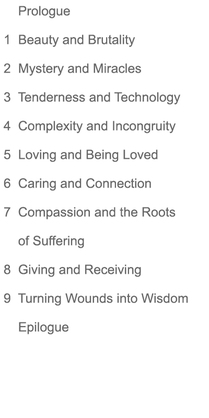Katherine - Chapter 1: Beauty and BrutalityI was a still-wet-behind-the-ears, third-year medical student when I met Katherine, and she won me to her cause immediately. A slender, probably once attractive woman in her late thirties, Katherine lay confined to bed in Room 301A on the medical ward with the most disturbing disease I had ever seen. Her diagnosis was far-advanced scleroderma, a condition in which a person’s immune system becomes confused. Instead of producing antibodies that defend against outside invaders, it produces antibodies that attack the person’s own connective tissues, those strong and marvelously flexible tissues that give our skin its supple quality and that form the bulwark of our muscles, our blood vessels and all our internal organs. The attacking antibodies rob these connective tissues of their marvelous elasticity, making them grow stiff and hard and resistant to movement. Unfortunately, modern medicine has not yet learned how to stop this grim process. Once started, the disease can progress slowly or more rapidly, affecting its victim in merely a few isolated places, or spreading throughout the person’s entire body, as it was doing in Katherine’s case.
Katherine had begun to develop the early signs of scleroderma a decade earlier. A feeling of tightness in her skin, together with a shiny appearance, developed first on her fingers and toes; then it also appeared on her elbows and knees. She had seen other patients with cases more advanced than hers in her specialist’s office, and she had known what was coming. As time went on, the disease progressed, steadily gaining ground with its leathery unyieldingness, eventually closing in so fully all around her that she could do nothing but lie stiff and motionless in bed. She was encased in a body that would one day become her own coffin.
To look at Katherine required a certain amount of courage, or else a defensive denial of feeling. She lay inert but fully present, like a tortoise pulled into its shell. Only her eyes moved as she gazed out from her fortress at the world going by. Her arms and legs were nearly useless, and her face could no longer smile. Talking and swallowing were very difficult. So, too, was the act of breathing, for the disease was increasingly claiming critical respiratory muscles and robbing her lungs of their ability to fill with air. Meanwhile, her tired tissues still registered pain all too well. Seeing her made my mind writhe in protest. How could life create such an awful fate for a human being, and why had she been selected to be one of those made to endure it?
Yet, for all the horror of her predicament, Katherine was not lost. Her steady, alert presence gave no hint of anger or self-pity or any other recriminating emotion I might have imagined a person would have under such daunting conditions. One way she could still express herself was with her eyes, and out of them poured an unjustified patience. For three weeks I visited her room nearly every day, going out of my way to spend time with her, touched by her equanimity, drawn by her strange contradictions: the softness that lay buried under stone, the openness behind the hardened encasement that enclosed her.
One Friday afternoon, the senior resident announced that Katherine needed to have a new intravenous line inserted, as her old one had stopped working. The line provided her with essential fluids and pain-relief medications. Accomplishing such a task in most patients was only modestly challenging, but for Katherine, replacing a nonfunctioning line would be no small matter. Locating the usual blood vessels under that tough skin would be nearly impossible. The resident said we were going to have to aim for the jugular vein, the largest vein in the neck and one that lay conveniently close to the surface. We gathered up the necessary supplies—syringes and needles, bags of IV fluid and plastic tubing, gauze pads and antiseptic solution—and marched to her room.
As the senior resident explained the procedure to Katherine, her eyes widened and she glanced at me with a look that made my throat catch.
“I’ll be with you,” I said and put my hand on her rigid arm, keeping it there while the residents surrounded her bed and placed white drapes across her chest and over her shoulders. As they set up their sterile field and laid out their instruments, she clung to me with her eyes.
What happened next can only be called gruesome. The vein proved exceedingly difficult to locate, and the senior resident’s needle pierced Katherine’s neck again and again as he searched for it. Having been edged away from Katherine’s side by the laboring residents, I stood nearby with eyes glued to the tip of the needle, begging life to cooperate. Eventually Katherine began to moan and attempt to turn her head, prompting one of the junior residents to lean over and subdue her with the pressure of both arms until the probing needle finally hit its mark.
As Katherine’s blood began to flow into the plastic tubing, the senior resident slipped the indwelling catheter forward from the needle into her vein and carefully stabilized it against her neck with surgical tape. He then connected the other end of the tubing to a bag of IV fluid, which he hung on the IV pole—only to reveal a new problem. The fluid was flowing into Katherine’s vein far too slowly, a sign that the catheter was not situated properly. It would have to be adjusted. While the senior resident tinkered with the catheter in Katherine’s neck, another resident suggested putting the IV bag in a higher location in order to get more gravitational pull on the fluid. I was immediately elected for the job and instructed to climb on top of the bedside table and stand there, holding the bag with arms stretched up as far above my head as possible.
Reluctantly, I left Katherine’s side and did as requested, standing for the longest time in the strangest pose, like a supplicant atop a pedestal, extending an offering upward to the higher realms in exchange for clemency toward one who was suffering below. It may have made no difference, or it may have been exactly what was needed. In either case, success was finally achieved. The fluid commenced a steady, reassuring drip into Katherine’s neck.
As soon as I climbed down from my perch, I leaned close to Katherine’s expressionless face and asked if she was all right. She gave a tiny nod and closed her eyes. Whether it was from exhaustion or from a desire to shut everything medical out of her awareness was not clear, but I took her closed eyes as a sign that she wanted to be finished with us.
“I’m sorry that was so hard,” I whispered. “I hope you can get some rest. I’ll see you on Monday.”
I then rejoined the little troupe with which I had come, and together we collected the various paraphernalia we had brought. With the room neat and tidy once again, we withdrew, leaving Katherine to recover in peace and quiet from what we had done to her.
On Monday morning when I returned to the ward, I headed straight for Room 301A to see how Katherine had fared over the weekend. She had been in my thoughts, and I was eager to learn if the new IV had provided her with a little respite. As I stepped into the room, what met my eyes was anything but what I had expected. Where Katherine had been was a freshly made bed, its white hospital sheets and cotton hospital blanket tucked tight and perfectly smooth. Not a single wrinkle indicated that a body had ever lain there. I stopped dead in my tracks, and my mind churned around in confusion, looking desperately for a rational explanation. “Surely there’s some mistake,” I thought. “Am I in the wrong room? Is she off having a test, or has she been transferred somewhere else?” But the bed was imperturbable. No, it answered with cool indifference. I am empty, not just temporarily vacated. She is gone. I hurried to find someone who could explain. The first person I encountered was the head nurse, sitting at the staff workstation. As I blurted out my question, she looked up with a sigh from the chart notes she was writing and confirmed what the empty bed had said. Katherine was gone. Her heart had given out Saturday night. Hearing the nurse’s clearly articulated words did not make any difference, however. Katherine’s absence was simply more than my mind could grasp. Feeling strangely numb and not knowing what else to do, I went off to begin my morning chores, which were rapidly piling up, telling myself that I should be happy she had finally escaped from her terrible imprisonment, glad she had no further need for our well-intentioned but lamentably harsh attempts to be of help. Not surprisingly, as true as these thoughts were, they did nothing to revive my spirit. Instead, a bleak sense of hollowness crouched along with me everywhere I went, all that day and the next. Yet that was not the end of the matter, for a deeper truth lay behind those rational thoughts, waiting for the initial shock to pass before revealing itself, and it took me by surprise when I discovered it on the third day. It was simple. I greatly missed the gentle presence that had peered out from the depths of Katherine’s landlocked eyes. The world seemed an emptier, more lonely place without the person in Room 301A whom I had grown to know and care about. As that recognition sank in, some very human part of me finally opened to the pain of Katherine’s passing. Like a dark flower blossoming in my heart, the sorrow of knowing I would never see her again spread it petals open wide. Then, at last, I shed the tears that wanted to come for not having been able to say good-bye to such a beautiful soul and tell her how much she had meant to me. |
Excerpt Table of Contents
|

